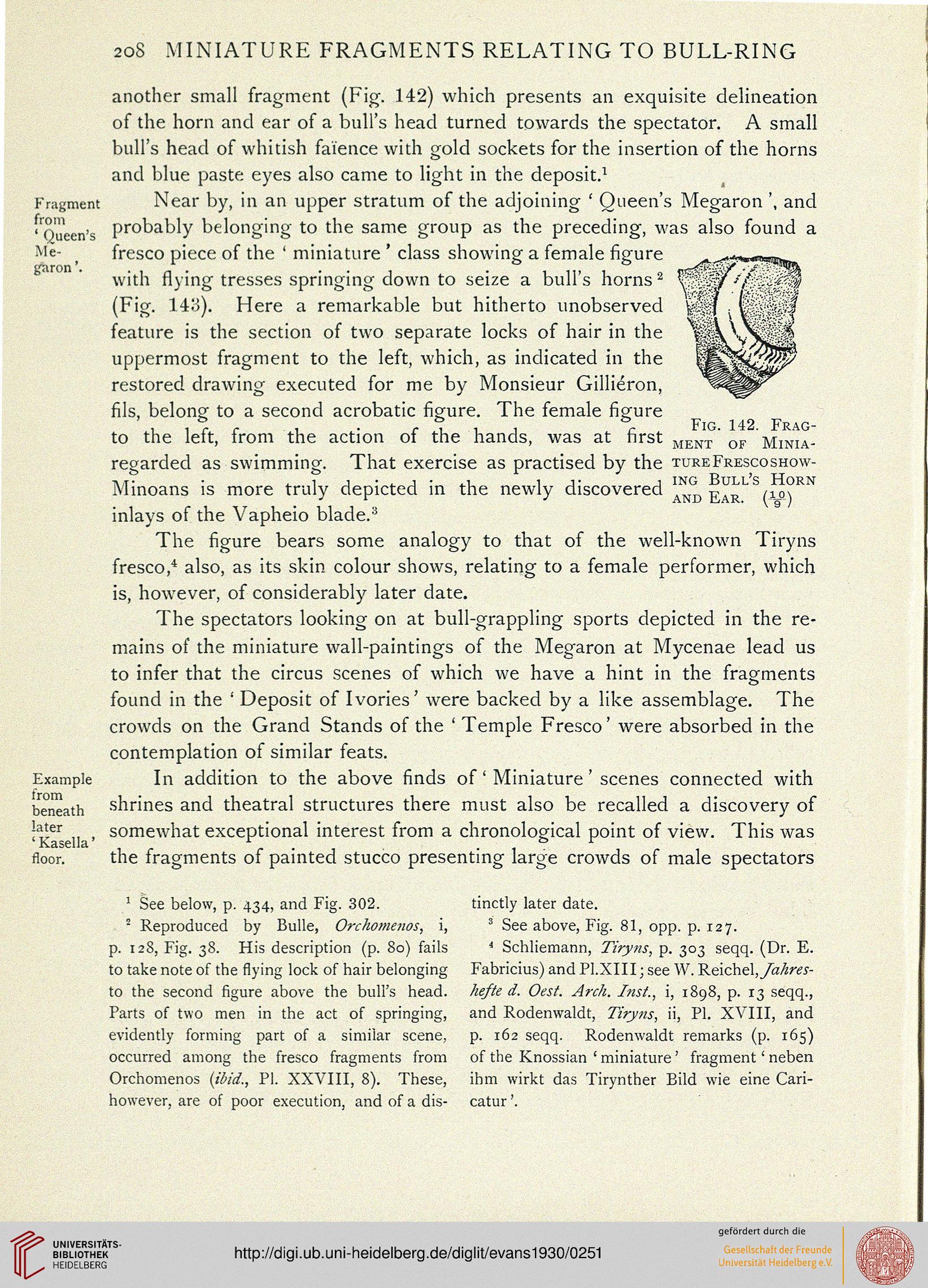2o8 MINIATURE FRAGMENTS RELATING TO BULL-RING
Fragment
from
' Queen's
Me-
garon '.
Example
from
beneath
later
'Kasella*
floor.
Fig. 142. Frag-
ment OF MlNIA-
another small fragment (Fig. 142) which presents an exquisite delineation
of the horn and ear of a bull's head turned towards the spectator. A small
bull's head of whitish faience with gold sockets for the insertion of the horns
and blue paste eyes also came to light in the deposit.1
Near by, in an upper stratum of the adjoining ' Queen's Megaron ', and
probably belonging to the same group as the preceding, was also found a
fresco piece of the ' miniature ' class showing a female figure
with flying tresses springing down to seize a bull's horns2 l~ /-•/
(Fig. 143). Here a remarkable but hitherto unobserved
feature is the section of two separate locks of hair in the
uppermost fragment to the left, which, as indicated in the
restored drawing executed for me by Monsieur Gillieron,
fils, belong to a second acrobatic figure. The female figure
to the left, from the action of the hands, was at first
regarded as swimming. That exercise as practised by the tureFrescoshow-
Minoans is more truly depicted in the newly discovered AND Ear ,10n
inlays of the Vapheio blade.3
The figure bears some analogy to that of the well-known Tiryns
fresco,4 also, as its skin colour shows, relating to a female performer, which
is, however, of considerably later date.
The spectators looking on at bull-grappling sports depicted in the re-
mains of the miniature wall-paintings of the Megaron at Mycenae lead us
to infer that the circus scenes of which we have a hint in the fragments
found in the ' Deposit of Ivories' were backed by a like assemblage. The
crowds on the Grand Stands of the ' Temple Fresco' were absorbed in the
contemplation of similar feats.
In addition to the above finds of' Miniature' scenes connected with
shrines and theatral structures there must also be recalled a discovery of
somewhat exceptional interest from a chronological point of view. This was
the fragments of painted stucco presenting large crowds of male spectators
1 See below, p. 434, and Fig. 302.
2 Reproduced by Bulle, Orchomenos, i,
p. 128, Fig. 38. His description (p. 80) fails
to take note of the flying lock of hair belonging
to the second figure above the bull's head.
Parts of two men in the act of springing,
evidently forming part of a similar scene,
occurred among the fresco fragments from
Orchomenos (ibid., PI. XXVIII, 8). These,
however, are of poor execution, and of a dis-
tinctly later date.
3 See above, Fig. 81, opp. p. 127.
* Schliemann, Tiryns, p. 303 seqq. (Dr. E.
Fabricius) and Pl.XIII; see W. Reichelj/fl/^j--
hefte d. Oest. Arch. Inst., i, 1898, p. 13 seqq.,
and Rodenwaldt, Tiryns, ii, PI. XVIII, and
p. 162 seqq. Rodenwaldt remarks (p. 165)
of the Knossian ' miniature' fragment' neben
ihm wirkt das Tirynther Eild wie eine Cari-
catur'.
Fragment
from
' Queen's
Me-
garon '.
Example
from
beneath
later
'Kasella*
floor.
Fig. 142. Frag-
ment OF MlNIA-
another small fragment (Fig. 142) which presents an exquisite delineation
of the horn and ear of a bull's head turned towards the spectator. A small
bull's head of whitish faience with gold sockets for the insertion of the horns
and blue paste eyes also came to light in the deposit.1
Near by, in an upper stratum of the adjoining ' Queen's Megaron ', and
probably belonging to the same group as the preceding, was also found a
fresco piece of the ' miniature ' class showing a female figure
with flying tresses springing down to seize a bull's horns2 l~ /-•/
(Fig. 143). Here a remarkable but hitherto unobserved
feature is the section of two separate locks of hair in the
uppermost fragment to the left, which, as indicated in the
restored drawing executed for me by Monsieur Gillieron,
fils, belong to a second acrobatic figure. The female figure
to the left, from the action of the hands, was at first
regarded as swimming. That exercise as practised by the tureFrescoshow-
Minoans is more truly depicted in the newly discovered AND Ear ,10n
inlays of the Vapheio blade.3
The figure bears some analogy to that of the well-known Tiryns
fresco,4 also, as its skin colour shows, relating to a female performer, which
is, however, of considerably later date.
The spectators looking on at bull-grappling sports depicted in the re-
mains of the miniature wall-paintings of the Megaron at Mycenae lead us
to infer that the circus scenes of which we have a hint in the fragments
found in the ' Deposit of Ivories' were backed by a like assemblage. The
crowds on the Grand Stands of the ' Temple Fresco' were absorbed in the
contemplation of similar feats.
In addition to the above finds of' Miniature' scenes connected with
shrines and theatral structures there must also be recalled a discovery of
somewhat exceptional interest from a chronological point of view. This was
the fragments of painted stucco presenting large crowds of male spectators
1 See below, p. 434, and Fig. 302.
2 Reproduced by Bulle, Orchomenos, i,
p. 128, Fig. 38. His description (p. 80) fails
to take note of the flying lock of hair belonging
to the second figure above the bull's head.
Parts of two men in the act of springing,
evidently forming part of a similar scene,
occurred among the fresco fragments from
Orchomenos (ibid., PI. XXVIII, 8). These,
however, are of poor execution, and of a dis-
tinctly later date.
3 See above, Fig. 81, opp. p. 127.
* Schliemann, Tiryns, p. 303 seqq. (Dr. E.
Fabricius) and Pl.XIII; see W. Reichelj/fl/^j--
hefte d. Oest. Arch. Inst., i, 1898, p. 13 seqq.,
and Rodenwaldt, Tiryns, ii, PI. XVIII, and
p. 162 seqq. Rodenwaldt remarks (p. 165)
of the Knossian ' miniature' fragment' neben
ihm wirkt das Tirynther Eild wie eine Cari-
catur'.




